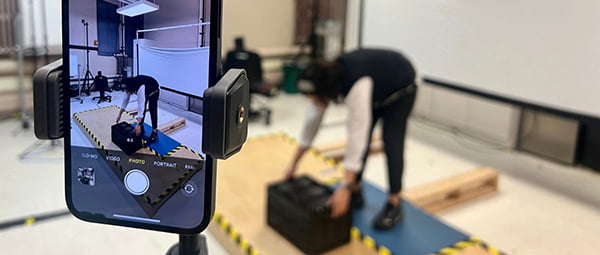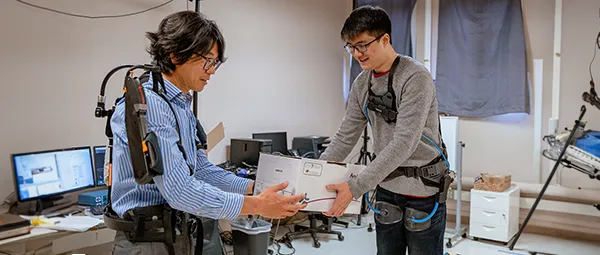News
Occupational Ergonomics and Biomechanics Laboratory
Feb. 13, 2024
Doctoral researcher develops an AI-powered tool to asses workplace injuries
Sept. 14, 2023
Grant to study exoskeletons among commercial fishermen
April 27, 2023
Applied ergonomics study finds fishermen-developed “banger bar” helps reduce risk of injury on crab boats

Oct. 14, 2022
OSU team receives $5.5 million Build Back Better grant
Oct. 9, 2021
OSU researchers to help make the 'deadliest catch' less deadly
Aug. 10, 2021
New grant will help OSU researchers find ways to prevent injury in Dungeness crab industry
Welcome Andrea to the OEB Lab
Andrea is currently an undergraduate student of Kinesiology at OSU. Andrea will work on research projects to evaluate exoskeletons in hazardous industries (June 15, 2023)
Welcome Matt to the OEB Lab
Matt is currently a MPH student of Environmental and Occupational Health at OSU with undergraduate degrees in Kinesiology and Public Health. Matt will work on research projects to evaluate exoskeletons in hazardous industries (April 5, 2023)
Welcome Mina to the OEB Lab who received a prestigious Provost scholarship.
Mina Salehi Sedeh is joinning the OEB lab from Fall 2022 with an outstanding track record and received a very competitive Provost scholarship. Mina will work on research projects to improve occupational health and safety for her doctoral degree (Sept 19, 2022)
OSU team received a federal grant of $5.5M (PI: Chung) to transform Oregon's forest industry. Jay Kim, as a Co-PI, will study exoskeletons for Forestry workers.
As a part of this 4-year project, OEB lab will evaluate the efficacy of wearable exoskeletons on improving occupational safety and health for the next-generation forestry operation as well as the sustainability and longevity of forestry workers in Oregon and beyond. (September 6, 2022)
Jay Kim received a NIOSH grant to evaluate exoskeletons for construction workers.
This 1-year research project will evaluate passive exoskeletons for electrical workers on a scissor lift in a dynamic conditions. (September 1, 2022)
Kiana successfully defended her PhD dissertation and she is now a post-doctoral fellow in the OEB Lab.
Dr. Kia's dissertation title was "Biomechanical and Cognitive Evaluation of Human-Computer Interfaces: From Keyboard to Virtual and Augmented Reality". (July 1, 2022)
Allen Chan received a prestigious Provost fellowship.
Allen joined the OEB lab in Fall 2021 with an outstanding track record and received a very competitive Provost fellowship. Allen will work on research projects to improve occupational health and safety for his doctoral degree (Sept 16, 2021)
Jay Kim received a U01 grant from National Institute for Occupational Safety and Health (NIOSH). ($895,000)
This 3-year project titled "Improving Dungeness crab vessel equipment: an ergonomic intervention to reduce risk for musculoskeletal
injuries and falls overboard" will focus on Dungeness crab fishing vessel design and quantify the impact of the current crab sorting table and blocks (a mechanized winch to pull the lines of crab pots) on injury risk. (August 10, 2021) Read a full story.
Jay Kim has accepted a scientific editor role for a prestigious journal in the field of Ergonomics, Applied Ergonomics.
The OEB lab director, Jay Kim, has been appointed as a scientific editor for Applied Ergonomics, one of the most prestigious journals in the field of Ergonomics.
Kiana Kia will do an internship at Tesla for Fall 2020.
Our PhD student, Kiana will be spending an academic term (Fall 2020) as an Ergonomics intern at Telsa. Congrats Kiana! Looking forward to hear your experience when you return.
Ashley Chan will graduate with Bachelor degree in Public Health Spring 2020.
Our Master's student, Hakim will graduate with Master's degree in Mechanical Engineering in Spring 2020. Congratulations to such a great accomplishment. She plans to start a Nursing school after her graduation.
Hakim Ishak will graduate with Masters of Engineering in Mechanical Engineering Winter 2020.
Our Master's student, Hakim will graduate with Master's degree in Mechanical Engineering in Winter 2020. Congratulations to such a great accomplishment. He will pursue his professional career in his home country, Malaysia.
Jay Kim received a pilot grant from PNASH (Pacific Northwest Agricultural Safety and Health Center). ($5,500)
This project titled "Systematic Evaluation of exoskeletons in reducing musculoskeletal disorders in manual timber felling" is to evaluate stakeholders’ awareness and acceptance of exoskeletons, and identify potential barriers/risks to implementation of exoskeletons in forestry. (November 2019)
Jay Kim received a U01 grant from National Institute for Occupational Safety and Health (NIOSH). ($531,812)
This project titled "Improving vessel equipment: Evaluating fishermen-led safety design ideas in the Dungeness crab fleet" is to objectively evaluate biomechanical loading during commercial crab harvesting tasks and evaluate an ergonomic intervention to reduce the biomechanical loading and associated injury risks in the commercial fishing industry. CDC/NIOSH Press release (September 11, 2019)
Jay Kim received a R21 grant from National Institute for Occupational Safety and Health (NIOSH). ($330,044)
This project titled "Effects of Multi-axial Whole Body Vibrations on Postural Stability" is to quantify the effects of occupational WBV exposures on postural balance and fall-relate injury risks in professional vehicle operators. (September 3, 2019)
Stevie Fitch will graduate with Masters of Public Health in Environmental and Occupational Health Spring 2019.
Our MPH student, Stevie will graduate with MPH in Enviromental and Occupational Health in Spring 2019. Congratulations to such a great accomplishment. She is currrently a consultant at British Standards Institution (BSI).
Stevie Fitch received research funding from Professional Training Opportunities Program (PTOP) through University of Washington. ($10,000)
Stevie will characterize Oregon public workers' exposure to whole body vibration (WBV) and develop training materials on WBV and its related health outcomes. Congrats Stevie! (January 2019)
Jay Kim received research funding from Office Ergonomics Research Committee. ($25,000)
This study will objectively quantify and compare biomechanical stress in neck and shoulder and cognitive brain function (executive function and working memory) during Virtual and Augmented Reality. (January 2019)
Jay Kim’s paper selected as editor’s choice
Assistant Professor Jay Kim’s recent paper, published in the latest issue of Annals of Work Exposures and Health, has been selected as the editor’s choice. “A randomized controlled trial of a truck seat intervention: Part 2 – Associations between whole-body vibration exposures and health outcomes” represents the first randomized controlled trial that showed that reducing whole-body vibration exposure improved low back pain and other musculoskeletal health outcomes among professional truck drivers. Read full post. (November 5, 2018)
Jay Kim and Jaejin Hwang (NIU) received research funding from UIC's NIOSH ERC center. ($25,000)
This study will evaluate muscle activity and joint net torque in hand, shoulder, and low back during patient transfer using four different engineering controls: a conventional cotton draw sheet, friction-reducing slide sheet, friction-reducing slide board, and air-assisted transfer device. (January 2018)
Jay Kim and Jaejin Hwang (NIU) received research funding from Office Ergonomics Research Committee. ($28,000)
This study will evaluate biomechanical exposures in the neck and upper extremities during augmented reality interactions to provide industry and users design recommendations and hand gesture usage guidelines. (January 2018)
Kiana Kia received prestigious HFES Student Author Presentation Support Award (SAPSA) at the 2017 HFES annual meeting .
Kiana presented her recent work that evaluated biomechanical exposures and usability among ultra-low key travel keyboards. (October 2017)
Rock ‘n’ Roll: Jay Kim aims to improve health for drivers and equipment operators
About 75 percent of workers who operate heavy machinery in these fields suffer from muscle and joint pain. In 2016, Kim and collaborators at the University of Washington and Northeastern University reported that low-back pain was the most prevalent of all the possible musculoskeletal ailments experienced by these drivers. Read full story. (August 3, 2017)
Jay Kim received research funding from Alpha Foundation. ($148,270)
This grant titled "Evaluating the Effects of Multi-axial Whole Body Vibration Exposure on Postural Stability in Mining Equipment Vehicle Operators" is to determine whether the effects of mining vehicle's WBV exposures on postural balance and fall-relate injury risks are different between vertical-dominant and multi-axial WBV exposures. (August 1, 2017)
Jay Kim received research funding from Alpha Foundation. ($150,000)
This grant titled "Effects of Whole Body Vibration Exposure on Physiological Stresses in Mining Heavy Equipment Vehicle Operators" is to quantify physiological stresses associated with WBV exposures using biological markers. This is the first study based on human model biomarker study to delineate underlying injury mechanisms associated with WBV exposures. (August 1, 2017)
Jay Kim received research funding from Alpha Foundation. ($361,407)
This grant titled “Systematic Evaluation of Multi-axial Suspension to Reduce Whole Body Vibration Exposures in Heavy Equipment Mining Vehicle Operators” will determine the efficacy of different engineering controls (mining vehicle seat suspensions) in reducing the multi-axial WBV exposures in mining vehicles and the associated biomechanical loading on the musculoskeletal system. (January 1, 2017)
Jay Kim received research funding from Bose Corporation. ($37,800)
This study will evaluate the effects of Whole Body Vibration on Non-driving Activity Performance in autonomous vehicle environment. (March 2017)
Jay Kim received research funding from InsightNow Inc. ($37,000)
This study will evaluate biomechanical exposures and usability of various nasal sprays. (January 2017)
Jay Kim received research funding from Office Ergonomics Research Committee. ($25,000)
This study will evaluate biomechanical exposures and usability on ultra-low travel keyboards to determine whether ultra-low travel keyboards will alter computer-related musculoskeletal injury risks and performance measures as compared to conventional computer keyboards. (January 2016)
Uncovering clues to alleviate bodily stress from heavy equipment vehicles
Jay and his team are looking to change that and have been using biomarkers in the blood – inflammatory responses and other stress indicators – to look at the exact relationships between the vibration and the physiological response from our bodies. This will make it possible to delineate the injury mechanism from WBV and low back pain and other musculoskeletal disorders. Read full story. (Synergies on Septeber 18, 2017)
Rock ‘n’ Roll: Jay Kim aims to improve health for drivers and equipment operators
One of the main objectives of Kim’s study is to provide physiological evidence that can explain the association between whole-body-vibration exposure and musculoskeletal disorders, especially in the neck and low-back regions. His goal is to contribute to improved engineering interventions (such as seating and machinery design) and better occupational health and well-being for workers. Read full story. (Terra Magazine on August 3, 2017 )
Researchers to study physical, mental stress of operating heavy equipment
“There is a critical need to determine the exact injury mechanisms related to WBV exposure,” Jay says. “Without a clear understanding of how these mechanisms cause the development of work-related musculoskeletal disorders and how they may be mitigated, these workers will continue to suffer injury.” Read full story. (Synergies on July 14, 2016)
Typing on a Tablet Can Put a Strain on Your Shoulders
Using touch-screen keyboards on tablet computers for long periods of time could lead to strain in the shoulders, suggests a study in the November issue of Applied Ergonomics that compared the musculoskeletal impact of three types of keyboards.
Read full story (The Wall Street Journal)
Find the Best Phone-Screen Size for You
Big screens are also better because, when it comes to touch screens, we all have fat fingers. Jay Kim and others studying tablets have found a correlation between typing speed and size of virtual keys.
Read full story (The Wall Street Journal)
Buckle Up: Test Driving Comfort Technology of Vehicle Seats
Have you ever taken that long car ride where you just can’t wait to get out? You say something along the lines of, “Ah my back is killing me” as you reach for the sky and hear every joint SNAP and POP. You know exactly what I am talking about, and so does Northern Illinois University professor Jay Kim.
Listen to or read full story (Northern Public Radio)




